Original URL: https://www.theregister.com/2013/11/14/review_lg_g2_smartphone/
LG’s G2: The phondleslab that wants you to TOUCH ITS BEHIND
The Android handset you’ll want to see the back of?
Posted in Personal Tech, 14th November 2013 09:04 GMT
Review For all the variation in screen size and the occasional BlackBerry with a keyboard, the design of modern smartphones is remarkably similar: an oblong lump with some sort of button arrangement below the screen and the power and volume controls scattered around the edge.
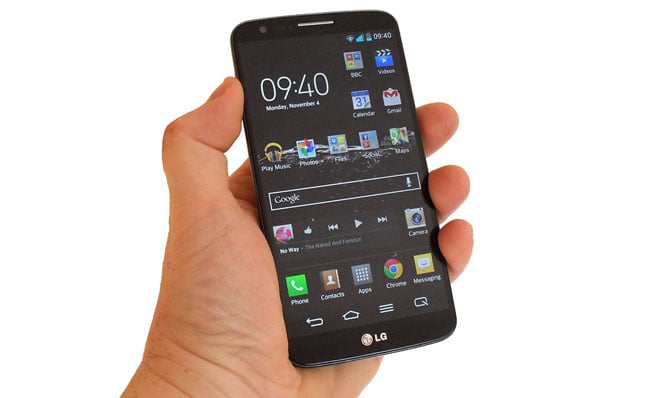
LG’s G2: not large in the hand
But no longer. With its new G2 flagship, LG has decided the best place for the volume and power toggles is on the back.
What surprised me isn’t that LG has done this – after all cooking up some sort of differentiation between one Android phone and another is becoming increasingly tough for OEMs – but that it turns out to be a bloody good idea.
Let’s start by having a fiddle with that odd-looking control on the back below the camera lens. The shiny chrome nub – it has a white LED surround too – in the middle is the power switch, the pressure plates above and below are the volume controls.
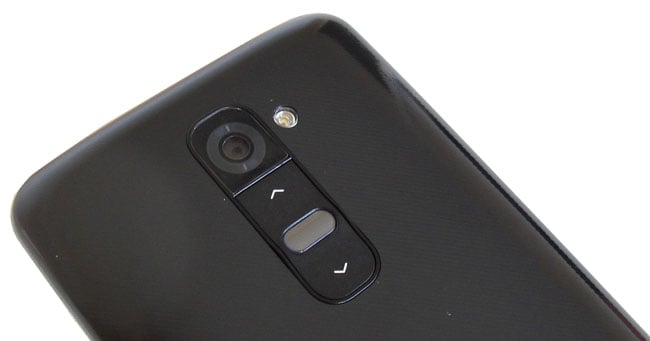
The button on the back is actually a darn good thing
All three have a small amount of physical give so you can tell when you’ve pressed them and they are all very easy to reach with the index finger of the hand you are holding your G2 in while at the same time maintaining a firm grip.
Using the rear controls becomes second nature very, very quickly - I’m talking about 20-odd minutes of use. After which time you wonder why the heck nobody has thought of doing this before.
The rear controls also have other uses: when the screen is locked a long press on the volume-up key launches the QuickMemo tool – I’ll come back to this shortly – while a long press on the down control kicks the camera into action.
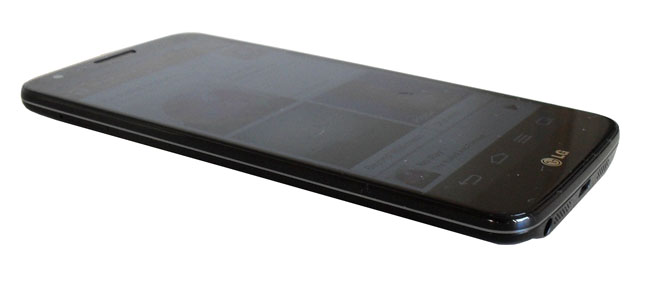
With buttons on the back, there’s nothing on the sides
The impressive usability of the G2 also has a lot to do with the basic design. The 5.2-inch, 1920 x 1080 – for a dots-per-inch density of 424dpi – IPS LCD display is not only bright, colourful and very good in sunlight but makes for a handset that while boasting a VLP™ screen size is still eminently useable with one hand.
Compared to the Samsung Galaxy S4, the G2 is actually 2mm taller, 2mm broader and 1mm thicker. It’s also 13g heavier. But those extras are close to irrelevant. The bezel surrounding the G2’s screen is about as thin as it’s possible to be without getting in the way of cost-effective fabrication and enhances the impression of the front of the G2 being all-screen.
While the front of the G2 is a sheet of Corning Gorilla Glass, the back is a plastic affair with a faux carbon-fibre weave pattern. It lets the side down a bit, aesthetically speaking. Of more fundamental importance is the fact that the rear cover is fixed in place thus kyboshing any plans you may have to replace the 3,000mAh SiO+ battery.
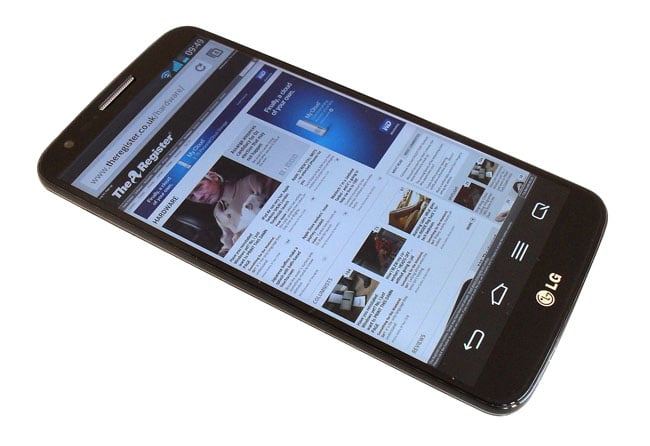
It’s a smooth and curvy design all round
I’ve not forgotten to mention the Micro SD card slot, it’s just that there isn’t one so you have to make do with the 16GB of built-in storage, which amounts to just under 11GB free after the system has put its towel on the sunloungers. Apparently there is a 32GB version too. No storage expansion and a fixed battery will be a dealbreaker for many and no doubt has brought a smile to the faces of the sales executives at Samsung.
Like the clappers
Thanks to its Qualcomm APQ8064T Snapdragon 600 chipset, which combines a quad-core 2.26GHz Krait 400 chip with 2GB of RAM and an Adreno 330 graphics wrangler, the G2 goes like the proverbial off a shovel.
The average AnTuTu benchmark score of 33,600 was near enough identical to that generated by the Samsung Galaxy Note 3, which may well have been cheating. Of course those are the same innards you’ll find the rather cheaper Nexus 5. Caveat emptor.
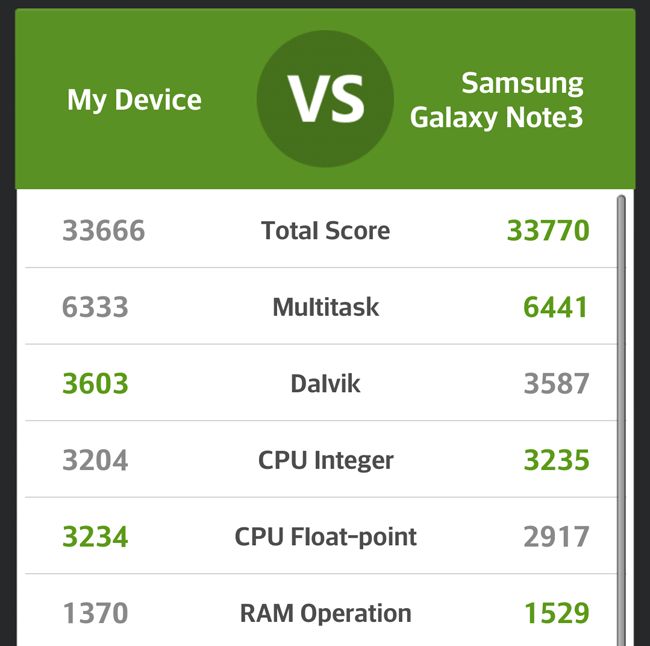
AnTuTu scores: the G2 vs the Samsung Note 3
Despite the fire-breathing performance, the G2 never ran hot and the chunky battery always proved good for at least a day-and-a-half of hard use. Looping a 1080p MP4 video file drained the battery in just over 13 hours, which is impressive.
The G2 runs Android 4.2.2 which is now two steps removed from absolute modernity. Like Samsung, LG has been hard at work tinkering with Android to add its own special features, but unlike Sammy’s TouchWiz, LG’s Optimus launcher comes across as much less of a witches’ brew. In my opinion there’s much less sacrifice of Android’s innate elegance and familiarity in the name of boasting as long a list of features as possible.
For instance, the eye-sensing features are restricted to core functions: pausing video when you look away and overriding the sleep time-out if you are still looking at the screen. That’s all the “smart view” I want on my handset, thank you very much.
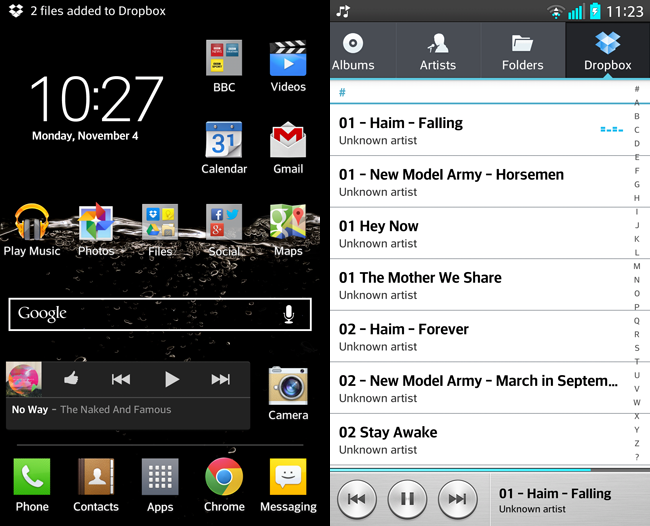
LG’s Optimus UI launcher (left) isn’t at all bad, but while the music player (right) talks to Dropbox, it doesn’t read metadata
There’s also something called Slide Aside which lets you make a three-fingered swipe between running apps though this really just replicates the stock Recent Apps function.
QuickMemo on the other hand, is of more use. It’s a simple-as-pie facility to take a screen grab and then doodle on it or jot down a quick memo.
There is also a selection of small apps, called QSlide apps, that can run in windows and six different layouts for the capacitive buttons below the screen, two of which include a fourth button to launch either QuickMemo or the QSlide apps. All of these features have uses but more importantly they are easy to get to grips with, easy to launch or equally easy to completely ignore.
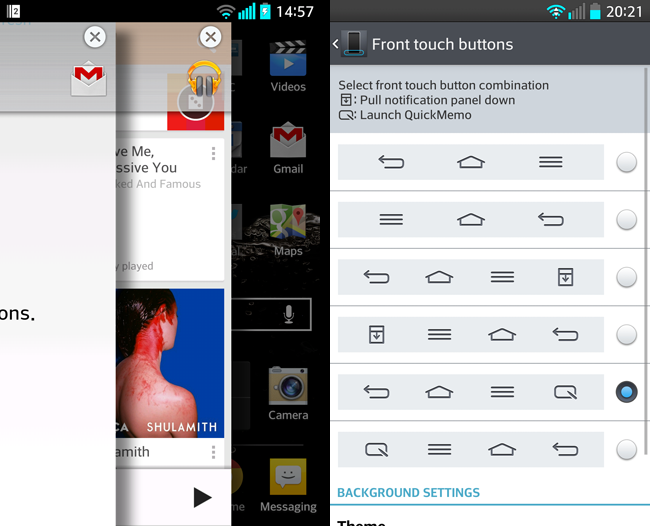
The Slide Aside feature (left) lets you flip between screens, and the G2 also lets you pick main button options (right)
The Optimus UI also looks a lot more like stock Android which works in its favour. By trying less hard than Samsung to make its launcher not look like Google’s basic creation, LG has come up with something altogether more usable and less confusing.
A final Optimus feature that deserves a mention in dispatches is tap-to-wake – or KnockOn, as LG rather strangely calls it. As the name sort of suggests, a quick double-tap on the screen of a sleeping G2 brings it to life while the reverse sends it back to sleep. You need to tap on an empty bit of screen to send it to sleep but a tap on the status bar will do the job if the screen if jammed full of apps and widgets or you have an app running full screen. It’s a peripheral feature but one I found myself using more and more often.
Firmware features
Open up the app tray and you will find quite a few bespoke LG apps which you are stuck with unless you fancy rooting your handset. Let’s be honest, most people don’t. The video and music players are both very good, the former having a nifty search feature that lets you search by frame but only changing to the searched-for scene when you tap the search bar.
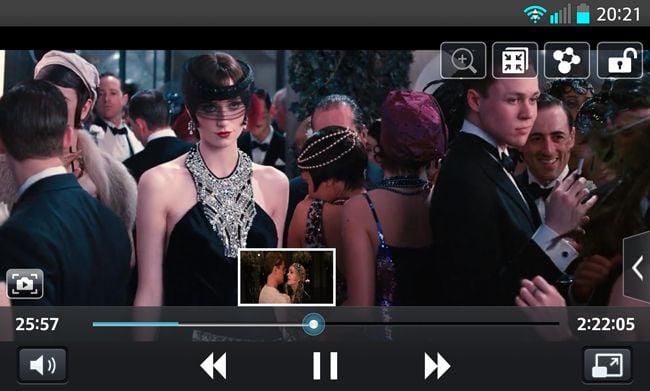
The G2‘s video player is excellent
The music app will stream tunes from your DropBox account. The cloud-connected file browser, gallery and TV remote are a cut above the average too, though the gallery app, like all of its kind, is being rendered obsolete by Google’s new Photos app.
The 13MP main camera boasts some basic image stabilisation and photos taken with with it demonstrated fine levels of detail and very little noise. Colours looked accurate and the white balance was good too.
The G2 can record 1080p videos at 30fps but if you ask it to capture a still image while doing so it only offers up a 1MP snap, which is a bit naff. That aside, the G2 is very bit as good a photographic tool as any other smartphone bar the Nokia 1020 or the Sony Xperia Z1. The 2.1MP webcam can produce a good selfie too.
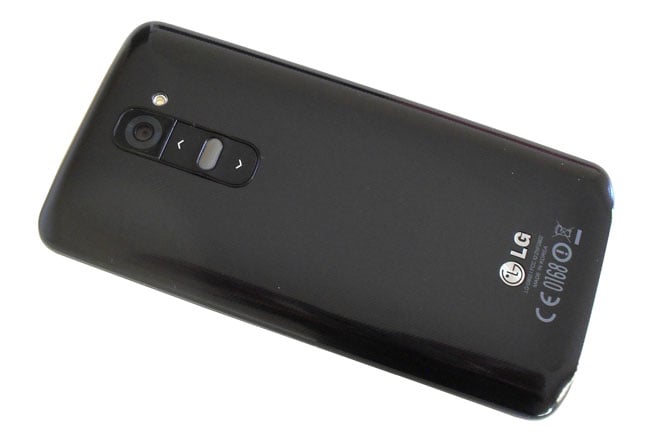
The back is fixed down, so don’t expect to swap batteries
A few final peculiarities to mention: the micro USB port, while happily supporting On-The-Go Hosting and media playback, needs a SlimPort rather than MHL cable for the latter. There’s also an FM radio which is an increasing rarity these days and, even more rare, support for 24-bit/192KHz audio playback. The music player can handle Flac files, the unexpandable storage permitting.
As for the nuts and bolts, the G2 is every bit as well endowed as you’d expect a flagship from a major Korean phone firm to be. There’s dual-band 802.11ac Wi-Fi, an IR blaster, Bluetooth 4.0, an NFC pick-up and, of course, support for 4G/LTE.
There is even a very decent pair of speakers built into the bottom edge of the handset – the best sounding pair this side of the HTC One, in fact, though their positioning means they are rather too easy to muffle when you are holding the phone in landscape for gaming. Wireless reception and call quality were well up to snuff.
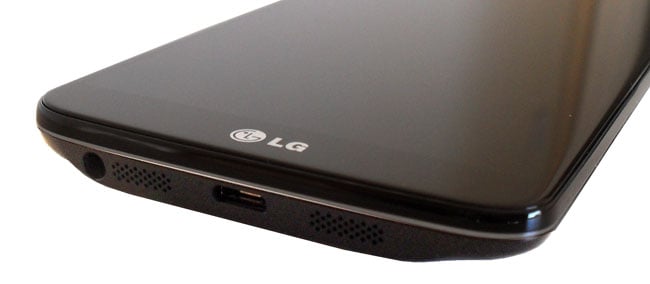
A decent pair of speakers
The Reg Verdict
If you can live with the fixed battery and equally fixed storage, the G2 is a rather impressive bag of tricks. It’s surprisingly small and svelte for something with a 5.2-inch screen and that screen is a very good example of the breed.
The battery is usefully larger – to the tune of 400mAh – than that fitted to the Galaxy S4, and the camera is one of the best fitted to any Android smartphone.
The stand-out feature, though, are those rear-mounted controls, which really do make this large handset much easier to use. ®